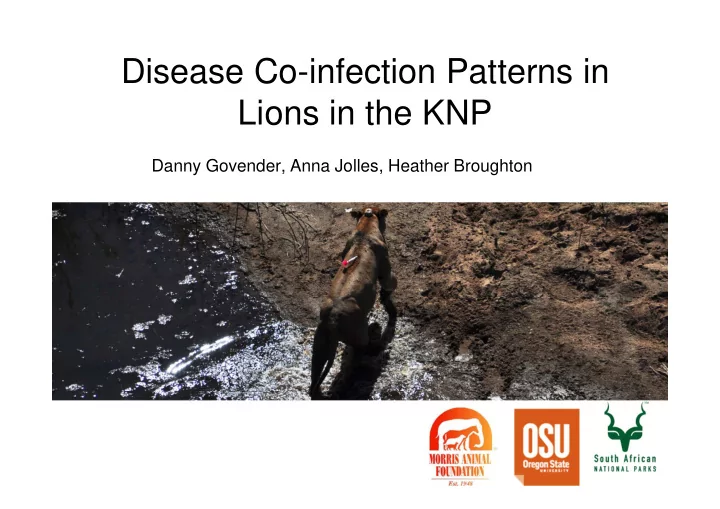

Disease Co-infection Patterns in Lions in the KNP Danny Govender, Anna Jolles, Heather Broughton
Agriculture vs Conservation - In large free-ranging systems disease is seen as an important driver - When would we be concerned? 1) Small populations exposed to emerging diseases 2) Disease dynamics that are slower than host dynamics providing little selective pressure 3) Synergistic co-infections with other parasites that may alter hosts ability to respond to disease challenge.
Most organisms are parasites… … numerically, and in terms of species richness
Most individual hosts, and all animal populations, are infected with multiple parasites.
� More specifically, are there parasite species that play a keystone role in structuring the parasite community found in a host population? � So, what processes structure parasite communities sharing a host population?
Parasites interact via ecological and immunologic mechanisms: • Ecological mechanisms (bottom up): – Direct competition for space / resources – Chemical or mechanical modification of the host environment – Ecological interference
Immunological mechanisms (top-down): i. Immunosuppression ii. Cross-immunity to similar parasites iii. Co-regulated immune responses to micro-and macroparasites Intracellular Extracellular parasites parasites e.g. Viruses, some e.g macroparasites bacteria Cell-mediated Humoral immunity immunity Th2 Th1 downregulation
What makes a keystone parasite? � broad effects on many other parasite species; most likely by: -Suppressing or biasing host immunity. -Being reasonably common in the host population ( � not extremely virulent ). -Causing lasting immunological changes in individual hosts ( � chronic infections ).
Candidate parasite taxa: • Chronic macroparasitic infections, e.g. GI helminths • Chronic microparasitic infections, e.g. – Mycobaterium TB complex – Immunodeficiency viruses!
Study system: FIV in African lions. -Lentivirus closely related to HIV and SIV. -Spread via bites and scratches. -Broader cell tropism than HIV. -Most felids infected with strains of FIVs. -Causes feline AIDS in domestic cats. -Causes increased aggression in domestic cats.. -FIV in lions relatively benign. -Coinfection consequences of FIV in lions not yet studied.
Lion population of Kruger National Park, South Africa - Approx 1700 lions - Prides of 5-15 individuals Territories 40-90km 2 in south, 300-600km 2 in north - - Female pride membership stable; adult male pride tenure ~ 2 yrs. - Many infections, viral, GI parasite, hemoparasite, bacterial…
Pilot study - aims: 1. Assess age-sex & geographic distribution of FIV infection in KNP lions. 2. Evaluate clinical effects and coinfections. 3. Establish immunological tools for lions.
Methods - Work in conjunction with ongoing lion demographic study. - Captures in 30 prides. - Basic clinical assessment, sample collection. - Viral serology, fecal parasitology. - Hematology, BKA, LPA, flow cytometry.
Pilot study results – FIV distribution: - 62 lions captured April 2010, southern KNP - 37 lions captured Aug 2010, northern KNP - FIV prevalence: 53% FIV seroprevalence increases with age (χ 2 = 12.01, p = 0.0005) Prevalence may be higher in males than females (63.4% vs. 45.5%; χ 2 = 2.95, p = 0.08) No difference in seroprevalence between north and south (χ 2 = 0.06, p = 0.81).
Pilot study results – clinical data: FIV+ lions may be more likely than FIV- lions to suffer from: -Ocular lesions ( χ 2 = 3.5, p = 0.06) -Gingivitis ( χ 2 = 2.91, p = 0.09) -Enlarged lymph nodes (F ratio = 4.02, p < 0.05) No differences detected in body mass, condition, hygromas, bites & scratches, coat, dehydration..
Pilot study results – immunology: • Bacterial killing assay • Lymphocyte proliferation assay • Flow cytometry
Pilot study results – coinfections: - FIV+ lions have a richer parasite community (viruses, GI parasites, hemoparasites) than FIV- lions (F ratio = 5.01, p = 0.0325) - FIV+ lions are less likely to seropositive for canine distemper (17% vs 28% prevalence; χ 2 = 3.99, p = 0.046); - but more likely to be infected with ascarids (62% vs 43% prevalence; χ 2 = 4.58, p = 0.032). - No differences detected for infections with parvovirus, calicivirus, coronavirus, tapeworm, hookworm, coccidia, toxoplasma.
Future work (2011)- - Central area capture: Sep 2011 - Trouble-shoot flow cytometry - Hemoparasite PCR panel - Expand sample size for immune assays - Track movement and behavior…
Thanks! – SANParks Veterinary Wildlife Services and Scientific Services – Sam Ferreire, Darius Schoultz, Travis Smit for use of their photos – Morris Animal Foundation – Lion Demography Project (PIs Sam Ferreira and Paul Funston)
Recommend
More recommend